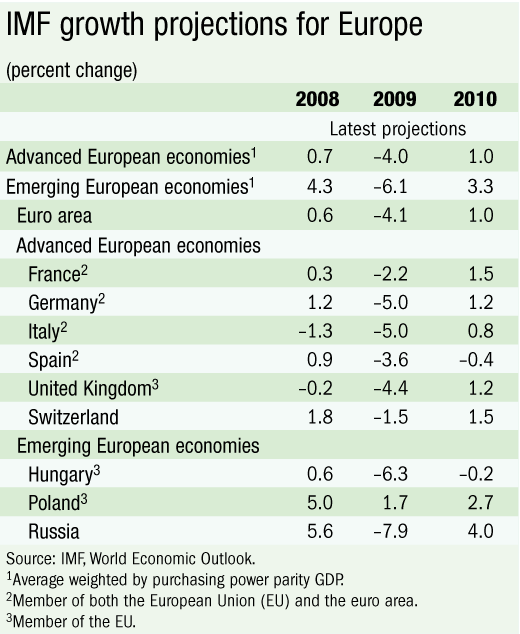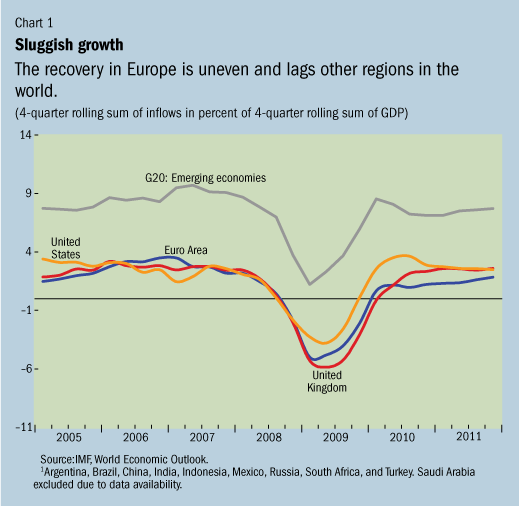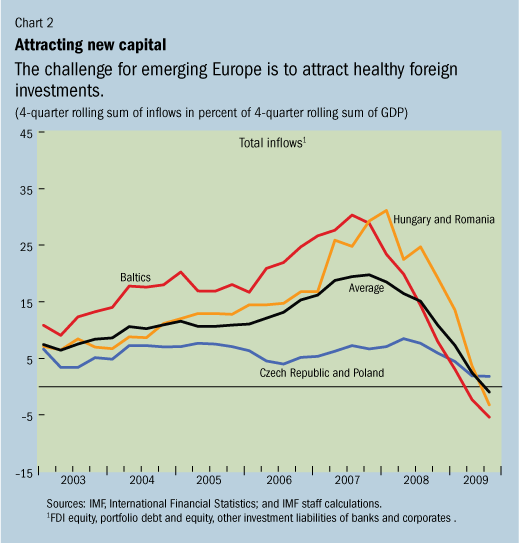
Typical street scene in Santa Ana, El Salvador. (Photo: iStock)
IMF Survey: Europe Moving to Restore Growth and Sustainability
May 11, 2010
- New European Stabilization Mechanism to underpin confidence
- Moderate, uneven recovery under way
- Large medium-term fiscal consolidation needed
A new European Stabilization Mechanism, announced May 9, is helping underpin confidence in Europe after a period of financial market stress, triggered by concerns over government solvency in several countries.

Europe’s recovery is weaker than in other regions, reflecting damaging impact of the global crisis, IMF report says (photo: Newscom)
REGIONAL ECONOMIC OUTLOOK
The European Union and the European Central Bank (ECB) have adopted a comprehensive package of measures to stabilize financial markets and support the adjustment of European economies. The European Union has also committed to accelerating structural reforms, strengthen fiscal discipline, and establish a permanent crisis resolution framework.
These measures will help restore stability, but Europe urgently needs to restore strong and sustainable growth. As discussed in the IMF’s biannual Regional Economic Outlook, written before the European Stabilization Mechanism was established, the ongoing recovery remains patchy and less dynamic than in other regions, reflecting the legacy of the crisis, and the situation in Greece created turmoil in financial markets that reduced risk appetite and lowered confidence.
“The recovery is under way in Europe, but it’s still much weaker than in other parts of the world,” Marek Belka, Director of the IMF’s European Department, said. “Lending conditions are still very tight, unemployment is high and still rising and, most importantly, people are worried about fiscal sustainability in a number of countries, which is depressing confidence in the outlook.”
While there is a need for continued support for the recovery and evolving financial and sovereign risks need attention, this is also the time to re-establish sustainable policies and move to decisively address medium- and long-term challenges. These challenges include getting public finances back on a sustainable track, reforming the financial system, and improving the efficiency of labor and product markets. Emerging Europe faces the added challenge of attracting new capital flows, and figuring out how to manage them well.
Outlook for Europe
Growth is expected to remain uneven and sluggish in 2010 (see table and Chart 1) because the forces that typically drive a recovery are weaker than usual, but it will pick up in 2011. Europe’s recovery is weaker than in other regions, reflecting the damaging impact of the global crisis.

Tightly integrated economies and the reliance of Europe’s largest countries on exports made the region particularly vulnerable to the collapse in global trade and capital flows. In some countries, domestic demand also suffered from the unwinding of homegrown financial excesses: real estate bubbles burst, credit booms turned into busts, and reckless government borrowing forced large fiscal adjustments.

Sustainable policies
A sustainable recovery requires sustainable policies. While the recovery still needs short-run support, the limits of what can be achieved have now become evident. On the fiscal area, large stimulus is on a collision course with solvency. Indeed, in some countries that collision has already occurred, demanding immediate fiscal adjustment. In general, however, stabilizing public debts in the short run is neither feasible nor desirable, given the magnitude of the required fiscal retrenchment and the risk of slowing the recovery.
Instead, governments should seek to consolidate their budgets over the medium term, including through a comprehensive reform of entitlement programs such as pensions and health care benefits, so that government finances are better able to cope with the imminent pressures from population aging.
Although the scale of the needed adjustment is not unprecedented, plans in many European countries will need to be more ambitious and specific. For countries that already suffer from low fiscal credibility, more immediate and forceful action is unavoidable. The EU’s commitment, announced May 9, to accelerate reforms that will strengthen fiscal discipline is a big step forward in this regard.
In the financial sector, the current tensions have required renewed extraordinary measures. The ECB’s decision on May 9 to launch a Securities Market Program that will allow it purchase securities in markets it deems are dysfunctional is a welcome step that will help restore confidence. Additional liquidity support and the reactivation of the ECB’s temporary swap lines with the U.S. Federal Reserve in coordination with the Bank of Canada, the Bank of England, the Bank of Japan, and the Swiss National Bank, constitute additional confidence-building measures.
However, once current risks abate, sustainable policies call for a withdrawal of blanket guarantees and a normalization of liquidity support while dealing with weaker institutions at an individual level. This will help minimize distortions and help financial markets to sustain the recovery.
Coordinating across countries and policies
The risk of unintended spillovers across countries calls for effective coordination of all remaining crisis measures, as well as off the eventual exit. Because the various policy objectives― macroeconomic stability, financial stability, and fiscal sustainability―are so closely connected, policymakers also need to pay close attention to the sequencing of policies. For example, lifting uncertainty on the new regulatory standards of the financial sector would help normalize credit conditions, enhance monetary policy effectiveness, and ultimately aid the unwinding of fiscal stimulus measures.
In the EU, coordination has taken place through existing procedures and common policies. While there is room for improvement, the Excessive Deficit Procedure has helped anchor fiscal adjustment, and the EU’s common competition policy has been used to coordinate state assistance to the financial sector.
Completing Europe’s policy frameworks is another pressing task. This includes the need to build on progress in supervision and macroprudential policy to strengthen cross-border crisis management, improving the functioning of product and labor markets, and addressing the deficiencies in the euro area’s fiscal architecture exposed by the debt crisis in Greece—in particular, insufficient surveillance and discipline during good times. The EU announced May 9 it is now committed to establishing a permanent crisis resolution framework.
Managing capital inflows
For emerging Europe, the key policy challenge will be attracting and harnessing healthy capital inflows to restore economic growth. Many countries in eastern and central Europe suffered from excessive inflows prior to the crisis, associated with booming credit markets and overheated growth (see Chart 2). As policymakers became increasingly worried about rising vulnerabilities associated with these developments, many of them resorted to prudential policies as a way to both stem and influence the composition of those flows.

These pre-crisis trends provide a number of important policy lessons. For countries that are already experiencing a resumption of inflows, macroeconomic policies will be critical to stemming an excessive surge. For countries with pegged exchange rates, the best response to speculative inflows is to tighten fiscal policies. For countries without pegged exchange rates, the most effective response could be to let the currency appreciate. A freely floating exchange rate is also helpful in preventing excessive inflows that could lead to new vulnerabilities.
Such macroeconomic policies should be accompanied by efforts to improve the overall stability of the increasingly integrated financial system in the region. Prudential tools such as capital requirements on foreign borrowing could slow excessive inflows and the buildup of risks in banks. Higher risk weights on loans to certain sectors could build buffers in the banking system and prevent overheating in these sectors. Supportive macroeconomic policies and effective cross-border financial supervision will also be needed to sustain the resilience of the financial system.
In countries where capital inflows have yet to resume, policymakers will need to rethink the sources of economic growth. During the boom years, real estate, construction, and finance were very profitable in emerging Europe—much more so than manufacturing. Now, much of the growth will have to come from exports. While this transformation should take place in the private sector, it will require support from macroeconomic policies. Policymakers should encourage labor mobility to restore the balance between the various sectors of the economy, invest in training to ensure that the work force has the necessary skills, and address bottlenecks to growth in terms of infrastructure.







